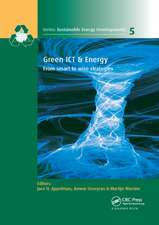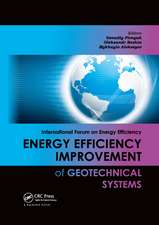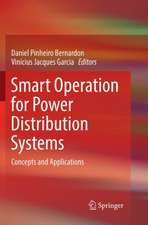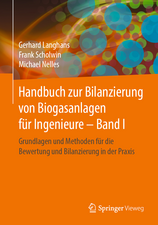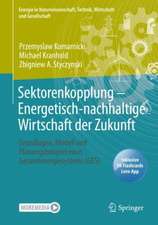Sector Coupling - Energy-Sustainable Economy of the Future: Fundamentals, Model and Planning Example of a General Energy System (GES)
Autor Przemyslaw Komarnicki, Michael Kranhold, Zbigniew A. Styczynskien Limba Engleză Paperback – dec 2023
| Toate formatele și edițiile | Preț | Express |
|---|---|---|
| Paperback (1) | 638.57 lei 6-8 săpt. | |
| Springer Fachmedien Wiesbaden – dec 2023 | 638.57 lei 6-8 săpt. | |
| Hardback (1) | 784.79 lei 3-5 săpt. | |
| Springer Fachmedien Wiesbaden – 30 noi 2022 | 784.79 lei 3-5 săpt. |
Preț: 638.57 lei
Preț vechi: 751.25 lei
-15% Nou
Puncte Express: 958
Preț estimativ în valută:
122.19€ • 130.66$ • 101.88£
122.19€ • 130.66$ • 101.88£
Carte tipărită la comandă
Livrare economică 18 aprilie-02 mai
Preluare comenzi: 021 569.72.76
Specificații
ISBN-13: 9783658381134
ISBN-10: 3658381132
Pagini: 209
Ilustrații: XVIII, 209 p. 1 illus.
Dimensiuni: 168 x 240 mm
Greutate: 0.37 kg
Ediția:1st ed. 2023
Editura: Springer Fachmedien Wiesbaden
Colecția Springer
Locul publicării:Wiesbaden, Germany
ISBN-10: 3658381132
Pagini: 209
Ilustrații: XVIII, 209 p. 1 illus.
Dimensiuni: 168 x 240 mm
Greutate: 0.37 kg
Ediția:1st ed. 2023
Editura: Springer Fachmedien Wiesbaden
Colecția Springer
Locul publicării:Wiesbaden, Germany
Cuprins
Climate policy goals of sustainable energy supply.- Why do we need an overall energy system.- Energy consumption and CO2 emissions.- Sector coupling.- Paradigm shift caused by renewable generation.- Potentials of renewable generation.- Methodology and model construction for sector coupling.- Modeling of an overall energy system.- Hub model.- Temporal resolution of energy flows.- Substitution of energy yields.- Optimization of an overall energy system.- Energy use sectors and their energy consumption.- Energy supply and the role of hydrogen.- Net-Zero-Factory.- Electric mobility.- Optimization of an overall energy system. Optimization of an overall energy system.- Optimization of an overall energy system.- Energy use sectors and their energy consumption.- Energy supply as well as the role of hydrogen.- Net-Zero-Factory.- Electromobility.- Methodology of modelling the energy hub components.- Modelling of generation sectors.- Flexibility of an overall energy system.- Role of information and communication technology.- Perspectives of the overall energy system.
Notă biografică
Przemyslaw Komarnicki is head of the Department of Energy Systems and Infrastructures (ESI) at the Fraunhofer Institute IFF in Magdeburg and professor of electrical power systems engineering at Magdeburg-Stendal University.
Dipl.-Ing. Michael Kranhold is an authorised signatory and head of the customer management grid accounting department at the transmission system operator 50Hertz Transmission GmbH in Berlin. He is a member of ETG and CIGRE.
Univ. Prof. Dr. Zbigniew A. Styczynski was head of the Chair of Electrical Grids and Alternative Sources of Electrical Energy at Otto von Guericke University Magdeburg until April 2015.
Dipl.-Ing. Michael Kranhold is an authorised signatory and head of the customer management grid accounting department at the transmission system operator 50Hertz Transmission GmbH in Berlin. He is a member of ETG and CIGRE.
Univ. Prof. Dr. Zbigniew A. Styczynski was head of the Chair of Electrical Grids and Alternative Sources of Electrical Energy at Otto von Guericke University Magdeburg until April 2015.
Preface:
Prof. Dr. Antje Orths: Chief Engineer at Energinet; Convenor of ENTSO-E’s Offshore Development Core Group; Adjunct Professor of Renewable Energies/ Wind Energy; Member of the IEEE PES, the VDE and the Energy Systems Integration Group, Reston VA.
Textul de pe ultima copertă
Now that the energy turnaround has established itself at the beginning of this century as a buzzword but also as a trademark of the German way of generating energy from renewable sources, sector coupling can be understood as an extension of this idea to the entire economy. As far as the generation of electrical energy is concerned, the feasibility of a 100% renewable electrical energy system is now beyond doubt. It is therefore time to think about how the other sectors, apart from electricity, will function if 100% of energy is supplied as renewable electricity. Is that even possible? What other primary energy sources are needed, for example, to maintain the highly developed mobility of people or the industrial landscape?
The content
Climate Targets and Sustainable Energy Systems - Modelling the Energy Hub - Structure of Energy Consumption in Sectors - Storage Technologies and Systems - Sector Modelling - Flexibility Options and Digitalisation of the GES - International Perspective
The target group
- Students and lecturers from the fields of energy technology, energy systems engineering, electrical engineering and energy economics
- Practitioners interested in a refresher course and career changers in the energy sector
The authors
As active contemporary witnesses, the authors have accompanied the energy transition in Germany and Europe for more than 20 years. In development, applied research and industrial application, they have investigated a wide range of topics in this field within the framework of numerous joint projects.
Prof. Dr.-Ing. Przemyslaw Komarnicki is head of the Department of Energy Systems and Infrastructures (ESI) at the Fraunhofer Institute IFF in Magdeburg and professor of electrical power systems engineering at Magdeburg-Stendal University.
Dipl.-Ing. Michael Kranhold is director of Customor Management and Grid Sattlement Department at the transmission system operator 50Hertz Transmission GmbH in Berlin. He is a member of ETG and CIGRE.
Univ. Prof. Dr. Zbigniew A. Styczynski was head of the Chair of Electrical Grids and Alternative Sources of Electrical Energy at Otto von Guericke University Magdeburg until April 2015.
This book is a translation of an original German edition. The translation was done with the help of artificial intelligence (machine translation by the service DeepL.com). A subsequent human revision was done primarily in terms of content, so that the book will read stylistically differently from a conventional translation.
The content
Climate Targets and Sustainable Energy Systems - Modelling the Energy Hub - Structure of Energy Consumption in Sectors - Storage Technologies and Systems - Sector Modelling - Flexibility Options and Digitalisation of the GES - International Perspective
The target group
- Students and lecturers from the fields of energy technology, energy systems engineering, electrical engineering and energy economics
- Practitioners interested in a refresher course and career changers in the energy sector
The authors
As active contemporary witnesses, the authors have accompanied the energy transition in Germany and Europe for more than 20 years. In development, applied research and industrial application, they have investigated a wide range of topics in this field within the framework of numerous joint projects.
Prof. Dr.-Ing. Przemyslaw Komarnicki is head of the Department of Energy Systems and Infrastructures (ESI) at the Fraunhofer Institute IFF in Magdeburg and professor of electrical power systems engineering at Magdeburg-Stendal University.
Dipl.-Ing. Michael Kranhold is director of Customor Management and Grid Sattlement Department at the transmission system operator 50Hertz Transmission GmbH in Berlin. He is a member of ETG and CIGRE.
Univ. Prof. Dr. Zbigniew A. Styczynski was head of the Chair of Electrical Grids and Alternative Sources of Electrical Energy at Otto von Guericke University Magdeburg until April 2015.
This book is a translation of an original German edition. The translation was done with the help of artificial intelligence (machine translation by the service DeepL.com). A subsequent human revision was done primarily in terms of content, so that the book will read stylistically differently from a conventional translation.
Caracteristici
Structures and models for the energy system of the future Discusses the appropriate storage technologies and systems for a successful energy transition Shows flexibility options and considers international plans


